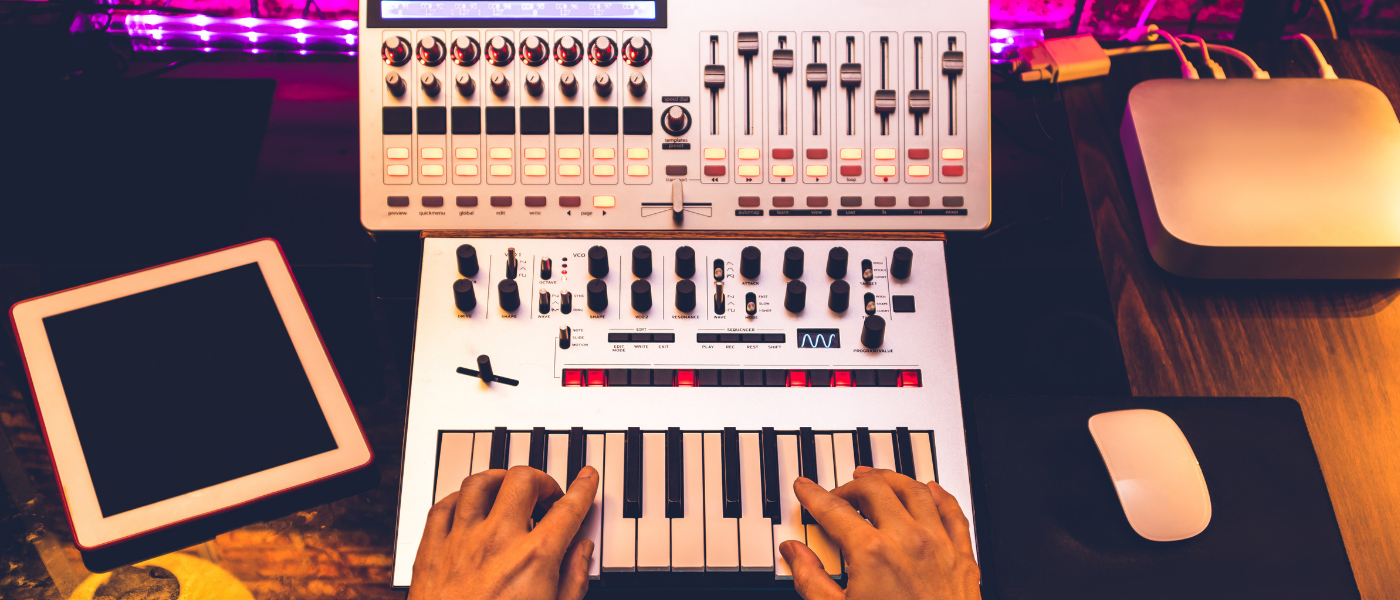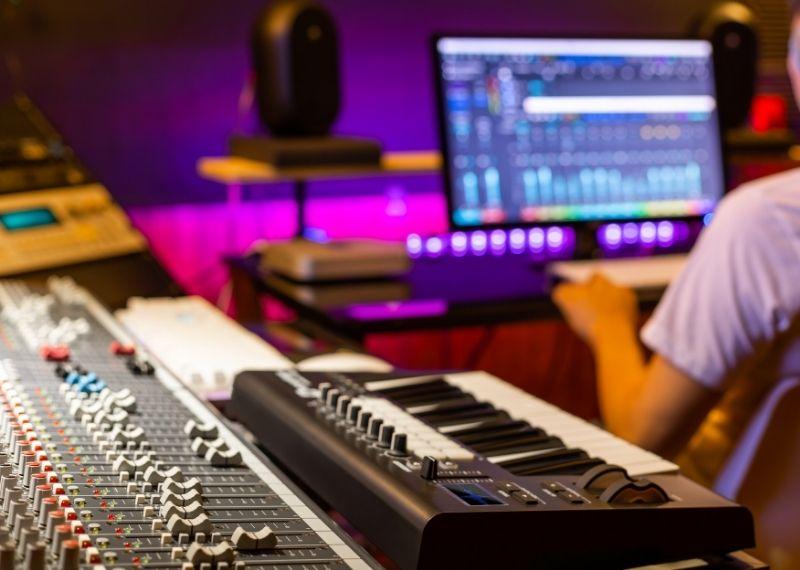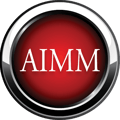What Equipment Do Music Producers Need?
Are you just starting out making music? Do you love recording, mixing, and mastering tracks?
Music Production can be a hefty load of work, but it can also be one of the most rewarding feelings in the world. If you are just starting out and not sure how to become a music producer, don't let the workload, equipment cost, or initial learning overwhelm you.
Before diving into the equipment, let's outline 5 beliefs that every beginning music producer should have:
- Trust your ears but always mix on multiple sound systems. Properly equalizing your tracks will make a more significant difference than any plugin or VST could.
- Don’t sprint through your songs. Each track you share should be something that you have given at least a few days of listening to beforehand.
- Get experimental: don’t constrain yourself into a single sound or genre, especially if it is one that emulates a currently popular sound. Chasing trends will always leave you playing catch up; the innovator is someone who doesn’t have to worry about trends.
- Don’t drain your bank account on hardware and software. It is incredibly tempting to scour the internet looking for the perfect plugin or sample to complete a track in progress. Instead, focus on developing the ability to create the sounds that you want with the tools that you have. The same rule applies to hardware. I sunk hundreds of dollars into various MIDI gadgets, controllers, and keyboards when I began making music. If I had focused on actually improving my production abilities, it would have been much more impactful (and cheaper)
- Continue to challenge yourself every day. Small steps forward are essential. Regardless of how long it takes you to learn a new skill or sound, strive to continue. As long as you make even a bit of time each day to learn something new about the tools you already have, you haven’t wasted your own time.
Equipment that Every Music Producer Needs - Table of Contents
- An Easy to use DAW
- A MIDI Controller
- A Pair of Studio Headphones
- An Audio Interface
- A Studio Recording Microphone
- A Subscription to a Sample Service
- Bonus: Serum
- Bonus: SPAN Signal Analyzer
The Importance of Proper Equipment
Given the tips above, it’s easy to overlook the equipment-side of production. Sure, talent and your marketing efforts go a long way, but top notch equipment is key.
While every single person has their unique preferences, some software and hardware have become the industry-standards for new producers.
These 5, affordable tools are sufficient to create the entirety of a composition.
8 Essentials for Every New Music Producer
1. Daw (Digital Audio Workstation)
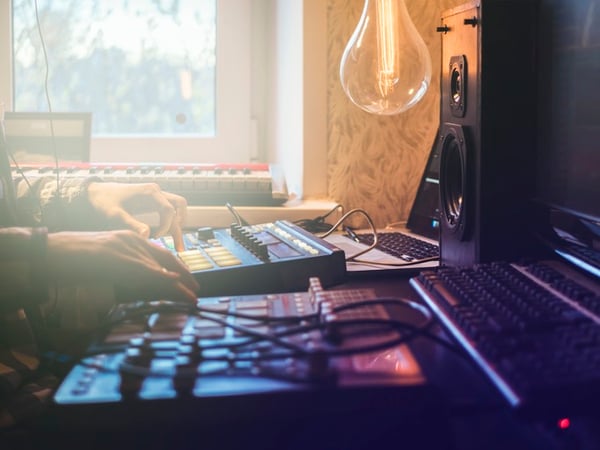
What is it: A DAW, or Digital Audio Workstation, is a software application for editing, recording, and creating audio files.
DAWs are considered to be the foundation of electronic music production- without one, you’d be recording on audiotape recorders. Currently, there are dozens of DAWs available, each with their features.
However, some common traits are present in almost all options. Multitrack recording, pitch/tempo modification, and filtering are all core features found across the market.
Why you need it: If you want to bake a cake, you need to have a pan. The same concept applies to DAWs.
There are alternatives, such as recording analog audio via tapes, but these options are cost-prohibitive and require massive amounts of talent to utilize in a meaningful way.
What Are Some Good Options: For new producers, Logic Pro or Ableton are two of the best options depending on what you want to accomplish with your sound.
Logic has much deeper editing abilities and can process massive session (think 100+ tracks) much more efficiently than Ableton, but is constrained only to Apple computers.
Ableton is much quicker to use for simple compositions and has the bonus of automatically matching tempos between different audio loops and clips, making live performances with just a controller extremely viable.
For those who want the most user-friendly DAW, try FL Studio. Its simplistic interface makes creating beats and loops incredibly intuitive for those new to producing. Keep in mind that FL Studio does not come with audio clips or the ability to directly record instrumentation (besides MIDI instruments).
If you want a better hands-on comparison, check out our article detailing the 3 best DAWs for beginners.
2. MIDI Controller
 What is it: Almost as important as your DAW is the MIDI controller you select to control it. MIDI, or Musical Instrument Digital Interface, is a universal technical standard that allows for communications between physical hardware and digital audio workstations.
What is it: Almost as important as your DAW is the MIDI controller you select to control it. MIDI, or Musical Instrument Digital Interface, is a universal technical standard that allows for communications between physical hardware and digital audio workstations.
One of the most common forms of MIDI controllers is keyboard controllers, which mimic the look and feel of traditional piano keyboards.
While keyboards are vital to producers who can already play one, grid controllers are a much more intuitive and inexpensive way to arrange beats and trigger samples.
Why you need it: A grid controller, such as the Novation Launchpad, allows for precise drum sequencing and live performance, with a DAW like Ableton Live.
What Are Some Good Options: Given their lower price points, grid controllers like the Novation Launchpad are a great way to dip your toes into MIDI controllers without financial barriers to entry.
3. A Pair of Studio Headphones
What is it: Studio headphones are headphones designed for professional work and have specific tunings to meet this goal.
Studio headphones differ from consumer and gaming headphones through their neutral sonic balancing. Essentially, studio headphones seek to output the least colored sounds possible in order for producers to mix their tracks as effectively as possible.
Without knowing what your song actually sounds like, correcting tonal imperfections during a mix-down will only exacerbate them.
Why you need it: For listening to your works in progress, there are two main options: monitors and headphones.
For new producers, headphones are the option you want to take. Studio monitors require substantial modifications to obtain clear sound, as their sounds are colored by factors including the shape of the speaker, the layout of the room they are sitting in, and much much more.
This leaves headphones as the primary option for new producers.
What Are Some Good Options: Two key things to keep in mind are avoid Bluetooth headphones and don’t master on “style” brands like Beats by Dre.
Bluetooth diminishes audio fidelity, and style headphones typically have distorted dynamics. The one advantage to brands like Beats or Skullcandy is for after you’ve finished mixing, you can hear how your track will sound to the masses. Sennheiser and Audio Technica both make strong entry-level headphones, but the ATH M20X might be the best low-cost option.
Coming in at around $50, they offer effective audio isolation and are closed-back; these make creating music in noisy environments a viable option.
For those looking for a high-end pair, the ATH-M50x delivers all of the benefits of the 20X turned up to eleven. Ultra-crisp dynamics, fantastic sound isolation, and sports a fully-collapsible design for easy transport.
4. An Audio Interface

What is it: Non-MIDI instruments such as guitars or vocals lack the universal connectivity of their peers. An audio interface is designed to address this problem.
The easiest way to conceptualize an audio interface is that they are the bridges between traditional analog sounds and digital audio.
For example, if you wanted to record a guitar with a 1/4th inch jack and a microphone with XLR connections, you would need a two channel audio interface to import the audio to your DAW.
Why you need it: When handling live instrumentation, a proper audio interface is required to translate the nuance of the acoustics into a digital audio file.
In a digital audio system, analog instruments such as pianos or guitars are recorded as analog electrical signals, which are then converted into a digital audio signal. Depending on your needs, different audio interfaces will work better than others.
What Are Some Good Options: For singer-songwriters, Native Instruments Komplete Audio 2 has two audio input channels and is portable enough to toss into a backpack easily.
As a general rule of thumb, audio interfaces exponentially increase in price with the more tracks that you want to record at once. However, companies such as Fireface offer audio interfaces that can accommodate more than 30 input channels- perfect for producing live orchestras.
5. A Studio Recording Mic

What is it: A studio recording microphone is a microphone created to capture sound and then subsequently convert it into a digital signal. Studio microphones are wired, fixed-in-position microphones designed to capture audio in a studio environment, such as a recording booth.
Typical studio microphones are either omnidirectional, which capture audio in a 3-dimensional sphere and can capture most types of audio, and cardioid microphones, which have “heart-shaped” sensitivity patterns to better capture vocals and speech.
Why you need it If you are new to producing music digitally, the chances are that you have a prior musical background.
If you want to translate those skills into your digital compositions, a proper studio recording microphone is essential. There are ten generally accepted varieties of microphones, although two types make up the majority of the production market.
- Condenser microphones use a vibrating diaphragm to produce audio signals and have a flatter frequency response than dynamic microphones, but uniformly capture audio. Essentially, one has to be careful about background sound bleeding if you choose a condenser mic.
- Dynamic microphones work via electromagnetic induction and tend to be much cheaper and hardier than condenser microphones. Their durability and pricing makes them ideal for on-stage performance and capturing audio in noisy environments.
What Are Some Good Options: For condenser microphones, the AKG C414 is an excellent option at its price. The gold standard of dynamic microphones is the Shure SM7B, but options at all price points are available.
6. Subscription to a Sample Service
What is it: The last key piece of (digital) equipment for beginner producers is a subscription to a sample service. Samples are portions of an existing sound recording, spliced into individual audio clips.
These services typically give you samples bundled by genre or instrument into sample packs, which often contain undesired sounds and can be quite costly.
A sample subscription service allows you to try multiple sounds or loops under one low monthly price.
Why You Need it: Sample services emerged relatively recently onto the music scene to solve this issue of selection, offering producers the ability to download and use a fixed number (or unlimited, depending on the plan and company) of samples from a variety of different sample packs.
For new producers, this means that almost no sounds are off-limits. Simply listen to sounds until something catches your ear, download it, and drag it into your DAW when you’re ready to make something new.
What Are Some Good Options: There are some solid gotos that should be considered including Noizz, Splice, or Loopmasters.
Each service has its own advantages: Splice has rent-to-own digital instruments and curated artist packs, Noizz has its own ecosystem with IOS sampler and instrument applications, and Loopmasters has a “Loopcloud” cloud application for organizing and managing samples on the go.
Bonus: Serum Synthesizer
What it is: One of the most recognizable instruments to new producers is the synthesizer, ubiquitous in its applications.
Most DAWs come with a variety of native synths that are sufficient for making decent sounds. However, producers who are looking to create more serious sounds should look into Serum.
Why You Need it: Serum, a wavetable synthesizer, comes packed with presets and wavetables that allow for instant experimentation and reiteration.
Serum’s user interface is especially appealing for new producers by allowing for direct visualization of how changes to a given parameter impact the overall sound of the synth. Given that most new producers are unfamiliar with the minutiae of sound synthesis, having the ability to see your changes in real-time helps to teach new producers how each element in a synth impacts its sonic output.
Given the prevalence of Serum over almost all other synths, it has practically become the SM7B of synthesizers. Plus, Splice offers a $10 a month rent-to-own copy- try it out and see if Serum is the right synth for you.
What Are Some Good Options: If Serum doesn’t catch your eye, Native Instrument’s Massive and Lennar Digital’s Sylenth are both versatile options.
Massive has incredibly deep sound processing abilities, but suffers from a cluttered and unclear user interface. Sylenth has tens of thousands of user-made presets readily available and uses minimal computing power, making it a viable choice for older computers.
Bonus: Website & Social Presence
When you're first starting out as a music producer it can be helpful to have a website and professional social media accounts.
Word of mouth and networking is huge in the industry, but if someone stumbles upon your work and is interested in reaching out to you, your website and social profiles are the first impression.
Make sure to keep your website clean and show off your best work. Need help building a website? You can get a step-by-step guide here.
For social profiles, make sure to optimize your bio and post as often as you can. Show behind the scenes of your work and videos of musicians you've worked with.
The opportunities are endless. If you need help making graphics for social posts then you need to check out Canva. There is no other platform that makes it easier.
Bonus: SPAN Signal Analyzer
What it is: One of the most important tools in a producer’s kit is often the most overlooked. Equalizing -EQing- your tracks is vital to producing professional-sounding songs by sculpting and filtering out specific tones from your track.
Why You Need it: To EQ a track accurately, a signal analyzer plugin is essential to isolate and identify particular sounds that need to be corrected. SPAN is a free tool that delivers precisely this. Using SPAN, a producer can check the precise frequencies present in a mix, isolate undesired tones, and use their equalizer to reduce or remove problematic bands of sound.
What Are Some Good Options: SPAN offers multi-channel/stereo analysis, peak/clipping identification, A/B grouping, and more. For those looking for higher-end signal analyzers, Izotope’s Ozone 8 offers exact multiband editing as well as automatic clipping removal and programmable tone sculpting.
How Much Will This Cost?
|
Item |
Budget |
Normal |
High-End |
|
DAW |
FL Studio Fruity Edition |
Ableton Suite |
Pro Tools |
|
MIDI Controller |
Novation Launchpad |
Akai Advance 61 |
Komplete Kontrol S88 |
|
Audio Interface |
Komplete Audio 2 |
Audient Sono |
Universal Audio Apollo Twin MkII DUO |
|
Studio Recording Microphone |
Shure SM7B |
Aston Stealth |
AKG C414 |
|
Studio Headphones |
ATX M20X |
ATX M50X |
Seinheiser HD-650 |
|
Subscription to a Sample Service |
Splice 100 Sample plan |
Splice 300 Sample Plan |
Splice 600 Sample Plan |
|
Serum |
N/a |
Rent-to-Own |
Buy |
|
Signal Analyzer |
SPAN |
SPAN Plus 44 |
Ozone 8 |
|
Total Price |
$1,000 |
$2,200 |
$5,250 |
Music Production Success Doesn't Happen Overnight
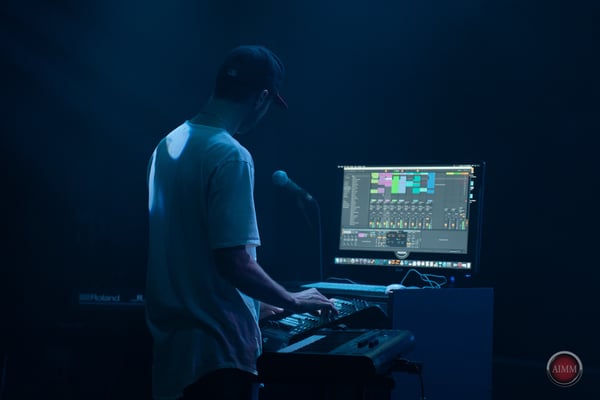
The most important thing for new producers to keep in mind is that practice makes perfect.
No one has used a DAW or a synth out of the box and created a masterpiece. Equipment helps, samples help, but repetition is crucial.
Consistent iteration and improvement is the path to producing something truly great. If you find yourself stuck on a project, create a new one and try something different. The goal is to practice creativity by designing new sounds, samples, and loops for future use.
Want Music Production to be Your Full-Time Career?
One of the best ways to get a jump-start on your career, develop life-long industry connections, and massively elevate your skill is the by attending an accredited music college.
At the Atlanta Institute of Music and Media, you'll have access to industry-standard equipment, hands-on and intricate coursework, and the opportunity to become Pro Tools Certified.
Follow in the footsteps of notable AIMM alumni like Kesha Lee, who earned a Grammy for her work on "This is America" with Childish Gambino or KEYZBABY, who just co-produced the #1 song in American, "WAP."
If Music Production is your passion, don't hesitate any longer. Learn more about AIMM's Music Production and Audio for Media Degree. AIMM even offers a fully Online Music Production Program.
Click below to discover how AIMM can help your music production career today.



